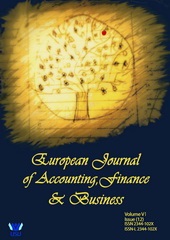|

ISSN: 2344 - 102X
ISSN-L: 2344 - 102X
Our journal is currently indexed in the following databases:
|
| |
Article from Volume 6, Number 1, Year 2018| EMERGING MARKET MULTINATIONALS: HOW LATECOMERS HAVE BECOME GLOBAL CHALLENGERS | 
Download | | Author(s): Rozalia Kicsi, Aurel Burciu | | DOI: 10.4316/EJAFB.2018.611 | | Abstract: The affirmation of multinational companies from emerging economies in the global economic area is often discussed as one of the significant trends in recent decades. Traditionally, literature on IB has developed a vein around the issue of multinational companies from developed economies. However, multinational companies from emerging economies offer a particular context that has imposed a paradigm shift and a refinement of approaches, which are also dictated by the specificities of developing economies. In this exploratory research, based on information provided by UNCTAD and Fortune Global 500 list, we aim to identify a series of trends and peculiarities in the corporate universe of developing economies. The analysis carried out leads to a series of conclusions regarding the dynamics and configuration of the world's most important multinational companies from developing economies. Although it is mainly an exploratory research, we appreciate that this approach leads to a deeper level of analysis, expanding the area of knowledge in the field, and creating a framework for new investigative perspectives. | | Keywords: Emerging Market Multinationals, Latecomers, Linkage, Leverage, Learning, State Capitalism. | References:
Books
1. Dunning, J. H. (1988). Explaining International Production. London: Unwin-Hyman.
2. Gerschenkron, A. (1962). Economic Backwardness In Historical Perspective. Cambridge, Mass.: Belknap Press.
3. Krugman, P. R., & Obstfeld, M. (2003). International Economics: Theory And Policy (6th Ed). Boston: Addison Wesley.
4. Musacchio, A., & Lazzarini, S. G. (2014). Reinventing State Capitalism: Leviathan In Business, Brazil And Beyond (y First Edition Edition). Cambridge, Massachusetts: Harvard University Press.
5. Williamson, P. J., Ramamurti, R., Fleury, A., & Fleury, M. T. L. (2013). The Competitive Advantage Of Emerging Market Multinationals. Cambridge University Press
Article From Journals
6. Goldstein, A. (2009). Multinational Companies From Emerging Economies. London: Palgrave Macmillan UK. Indian Journal Of Industrial Relations, 45(1), 137-147 Retrieved From: Https://doi.org/10.1057/9780230206335
7. Dunning, J. H. (2006). Comment On Dragon Multinationals: New Players In 21st Century Globalization. Asia Pacific Journal Of Management, 23(2), 139–141. Retrieved From:
Https://doi.org/10.1007/s10490-006-7161-1
8. Kedia, B., Gaffney, N., & Clampit, J. (2012). EMNEs And Knowledge-seeking FDI. Management International Review, 52(2), 155–173. Retrieved From: Https://doi.org/10.1007/s11575-012-0132-5
9. Dunning, J. H. (2001). The Eclectic (OLI) Paradigm Of International Production: Past, Present And Future. International Journal Of Economics And Business, 8(2),173-190.
10. Johanson, J., & Vahlne, Jan-Erik. (1977). The Internationalization Process Of The Firm-A Model Of Knowledge Development And Increasing Foreign Market Commitments. Journal Of International Business Studies, 8(1), 23–32. Retrieved From:htttp://www.jstor.org/stable/254397
11. Herciu, M. (2015). EMNCS – Lessons On The Way To An Innovationbased Development. Empirical Findings. Studies In Business And Economics, 10(2), 44–52.
Retrieved From: Https://doi.org/10.1515/sbe-2015-0019
12. Kumar, K. (1982). Third World Multinationals: A Growing Force In International Relations. International Studies Quarterly, 26(3), 397-424. Retrieved From: Https://doi.org/10.2307/2600427
13. Li, P. P. (2007). Toward An Integrated Theory Of Multinational Evolution: The Evidence Of Chinese Multinational Enterprises As Latecomers. Journal Of International Management,
13(3), 296–318. Retrieved From: Https://doi.org/10.1016/j.intman.2007.05.004
14. Mathews, J. A. (2002). Competitive Advantages Of The Latecomer Firm: A ResourceBased Account Of Industrial Catch-Up Strategies. Asia Pacific Journal Of Management, (19), 467–488.
15. Mathews, J. A. (2006). Dragon Multinationals: New Players In 21st Century Globalization.
Asia Pacific Journal Of Management, 23(1), 5–27. Retrieved From: Https://doi.org/10.1007/s10490-006-6113-0
16. Mathews, J. A. (2017). Dragon Multinationals Powered By Linkage, Leverage And Learning: A Review And Development. Asia Pacific Journal Of Management, 34(4), 769–775. Https://doi.org/10.1007/s10490-017-9543-y
17. McNally, C. A. (2012). Sino-Capitalism: China’s Reemergence And The International Political Economy. World Politics, 64(04), 741–776.
18. Slangen, A., & Hennart, J.-F. (2007). Greenfield Or Acquisition Entry: A Review Of The Empirical Foreign Establishment Mode Literature. Journal Of International Management, 13(4), 403–429. Retrieved From: Https://doi.org/10.1016/j.intman.2007.08.001
19. Van Apeldoorn, B., De Graaff, N., & Overbeek, H. (2012). The Rebound Of The Capitalist State: The Rearticulation Of The State–Capital Nexus In The Global Crisis. Globalizations,
9(4), 467–470. Retrieved From: Https://doi.org/10.1080/14747731.2012.699960
20. Vernon, R. (1966). International Investment And International Trade In The Product Cycle.
The Quarterly Journal Of Economics, 80(2), 190. Retrieved From: Https://doi.org/10.2307/1880689
Article From Conference Volume
21. Burciu, A., & Kicsi, R. (November, 28th-29th 2018). BRICS Multinationals: From "Niche Players" To World Players. The International Conference "Global Economy Under Crisis", 7th Edition. Ovidius University Of Constan?a.
Internet Documents
22. Fortune Global 500 List 2017: See Who Made It. (2017). Retrieved October 13, 2018, Retrieved From: From Http://fortune.com/global500/2017/
23. Development, U. N. C. On T. (2007). The Universe Of The Largest Transnational
Corporations. United Nations Publications, Retrieved From: Https://unctad.org/en/Docs/iteiia20072_en.pdf
24. Marinov, M., & Marinova, S. T. (2013). Successes And Challenges Of Emerging Economy Multinationals. Retrieved From:
Http://public.eblib.com/choice/publicfullrecord.aspx?p=1588743
25. Nolke, Andreas. (2014). Multinational Corporations From Emerging Markets: State
Capitalism 3.0. Retrieved November 25, 2018, From:
Https://www.readings.com.au/products/18082975/multinational-corporations-fromemerging-markets-state-capitalism-3-0
26. United Nations Conference On Trade And Development. (1999). World Investment Report 1999: Foreign Direct Investment And The Challenge Of Development. UN. Retrieved From: Https://doi.org/10.18356/8e79f24c-en
27. United Nations Conference On Trade And Development. (2007). World Investment Report 2006: FDI From Developing And Transition Economies-Implications For Development (Includes CD-ROM). UN. Retrieved From: Https://doi.org/10.18356/1d36bed0-en
28. UNCTAD. (2007). The Universe Of The Largest Transnational Corporations. United Nations Publications, Retrieved From: Https://unctad.org/en/Docs/iteiia20072_en.pdf
29. United Nations Conference On Trade And Development. (2018). World Investment Report 2018: Investment And New Industrial Policies. UN. Retrieved From: Https://doi.org/10.18356/ebb78749-en
30. World Bank. (2018). Foreign Investment Competitiveness Report. Retrieved November
12, 2018, From
Http://documents.worldbank.org/curated/en/169531510741671962/pdf/121404-PUBPUBLIC-PUBDATE-10-25-2017.pdf
|
| | Back to journal ... |
|
|
| |
|
|
|

